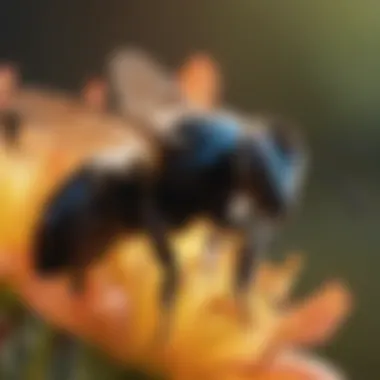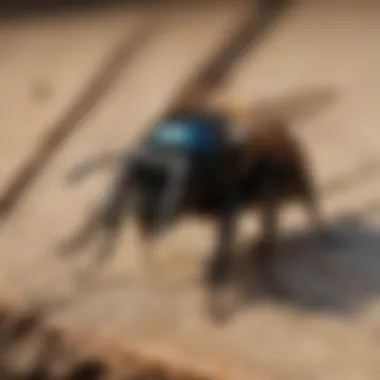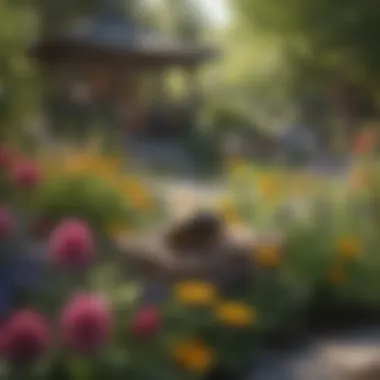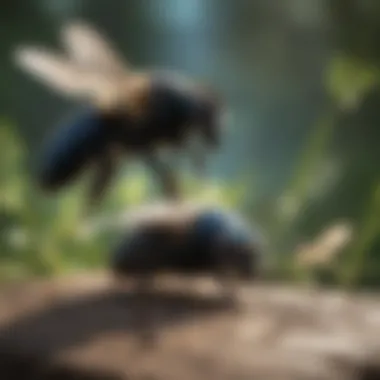How to Save a Carpenter Bee: Strategies and Considerations


Intro
Carpenter bees are often misunderstood creatures that play an essential role in our ecosystem. They assist in pollination, contributing to the growth of various plants, thereby supporting biodiversity. At the same time, their nesting habits can lead to significant damage to wooden structures, creating a conflict for homeowners and builders alike. Understanding these insects and finding ways to coexist without causing harm can help both the bees and human habitats thrive.
In this article, we will explore strategies to save carpenter bees while minimizing damage to wooden structures. This includes understanding their ecological importance, their behavioral traits, and sustainable practices that promote coexistence. The aim is to provide practical insights for homeowners and gardening enthusiasts seeking to maintain a balance between respecting these pollinators and protecting their properties.
Understanding Carpenter Bees
Carpenter bees belong to the genus Xylocopa. They are solitary bees and are often mistaken for bumblebees due to their similar appearance. However, they differ in nesting habits; carpenter bees bore into wood to create their nests, which can lead to structural concerns. While their behavior of remodelling wood might seem destructive, it is essential to recognize their benefits to the environment as effective pollinators.
Ecological Importance
Carpenter bees contribute significantly to the pollination of numerous flowers and crops. Their foraging behavior aids in the reproduction of plants, which in turn supports other wildlife. Additionally, they possess a unique ability to pollinate certain plants that require 'buzz pollination', a technique that sends vibrations through the flower to release pollen.
"Carpenter bees are crucial players in the ecosystem, providing essential pollination services that impact a wide range of flora."
Strategies for Coexistence
To protect both the carpenter bee population and one's property, several strategies can be adopted. Here are some essential methods homeowners can consider:
- Avoid Painting or Treating Untreated Wood: Carpenter bees prefer untreated wood for nesting. If you must use treated wood, choose coatings that do not contain strong preservatives, as these can deter bees from nesting elsewhere.
- Create Nesting Sites Away From Homes: Introduce designated nesting areas such as wooden blocks or logs placed away from structures. This helps in providing an alternative location for bees while protecting your home.
- Seal Existing Entrances: If there are already holes from carpenter bees, consider sealing them with appropriate wood filler or caulking after ensuring the bees are not active. This will prevent further damage and encourage bees to look for alternative nesting sites.
- Use Natural Deterrents: Certain natural deterrents like citrus oil or peppermint can be used around wooden structures to encourage bees to stay away without harming them.
By adopting these strategies, one can minimize potential damage while still ensuring that carpenter bees have a habitat to thrive in.
Finale
In achieving a balance between protecting carpenter bees and maintaining the integrity of wooden structures, it is vital for homeowners to implement thoughtful strategies. The ecological benefits provided by these bees are substantial, and their preservation is key to promoting biodiversity. Understanding their behavior, being proactive about preventative measures, and embracing sustainable practices will ensure that while we protect our homes, we also respect the essential role of carpenter bees in our environment.
Understanding Carpenter Bees
Understanding carpenter bees is essential for those looking to initiate strategies focused on their conservation while minimizing potential damage to wooden structures. These creatures contribute substantially to pollination, a vital process for the ecosystem, but their nesting habits often raise concerns among homeowners. By comprehending their behaviors and biology, individuals can address specific challenges related to both the conservation of these pollinators and the protection of their property. With this knowledge, effective coexistence strategies can be formulated.
Biology and Physiology
Anatomical features
Carpenter bees exhibit distinct anatomical features that help in their nesting processes. One key aspect is their robust, cylindrical body structure covered with dense hair that collects pollen. This feature not only aids in their efficiency as pollinators but also provides advantages during the nesting phase. The solid mandibles enable them to easily bore into wood, essentially creating tunnels for their larvae. While this adaptation is beneficial for the bee's lifecycle, it poses significant concerns for homeowners since the bees can cause structural damage if left unchecked.
Lifespan and lifecycle
The lifespan and lifecycle of carpenter bees are prominent factors in understanding their impact. Adult carpenter bees typically live for one season, with females overwintering in their nests. Their lifecycle includes egg laying, which takes place in the tunnels they create. This structure serves both as a site for their offspring and as a protective environment. This aspect is critical as understanding their lifecycle helps homeowners gauge the best times for intervention and prevention measures. Furthermore, knowing the timeline aids in planning effective strategies to mitigate conflicts arising from structural concerns.
Behavioral Patterns
Nesting habits


Nesting habits of carpenter bees are integral to comprehending their behavior and potential difficulties they may create for residences. Male carpenter bees often engage in territorial displays, while females are responsible for the nesting. They typically choose untreated wood for nesting, which may include softwoods like pine and cedar. This preference presents significant challenges. It highlights the necessity for homeowners to be proactive about treating wooden surfaces and sealing potential nesting sites. This can reduce problems before they begin.
Feeding preferences
Feeding preferences of carpenter bees complement their role as critical pollinators. They primarily feed on nectar and pollen from a variety of flowers, favoring those with large, open blooms. This choice of diet is important because it connects directly to the plants they pollinate. Understanding these feeding behaviors informs strategies for creating bee-friendly environments that encourage their presence while managing potential damage to wooden structures. Additionally, knowing their preferred plants helps in fostering local biodiversity, which is essential for a healthy ecosystem.
Differences Between Carpenter Bees and Bumblebees
Identifying characteristics
Identifying characteristics between carpenter bees and bumblebees plays an essential role in effective management strategies. Carpenter bees are typically larger and possess a shiny abdomen, contrasting with the furry, banded appearance of bumblebees. This distinction is beneficial, as it helps individuals recognize which bee species they are dealing with when developing conservation or management tactics. Furthermore, understanding these differences helps in reducing unnecessary fear or prejudice against carpenter bees, as they are generally less aggressive compared to bumblebees.
Habitat usage
Habitat usage sheds light on how carpenter bees operate within their environment compared to bumblebees. Carpenter bees prefer nesting in dry wood, which can lead them into structures built by humans, creating conflicts. This behavior highlights the importance of examining outdoor spaces, to not only understand where these bees might establish nests but also to develop strategies that incorporate their habitat needs. Knowledge of these patterns provides homeowners the opportunity to implement preemptive measures, ensuring a balanced coexistence with these vital pollinators.
The Ecological Role of Carpenter Bees
Carpenter bees are more than just pollinators; they play a significant role in maintaining ecological balance. Their activities contribute to the health and diversity of plant communities, which in turn supports numerous other organisms. Understanding their ecological role is vital for anyone interested in conservation strategies, especially homeowners who may see these bees as a threat to their property. Recognizing the benefits they bring ensures that efforts to save them are informed and effective.
Pollination Contributions
Plants they pollinate
Carpenter bees are effective pollinators for a variety of flowering plants. They exhibit a strong preference for certain species, including salvia, bluebell, and lavender. These plants benefit from the bees' foraging behaviors, as carpenter bees tend to visit multiple flowers in one go, increasing the chances of cross-pollination. This process enhances fruit and seed production, leading to healthier plant populations.
The key characteristic of the plants they pollinate is their reliance on bee activity for reproductive success. Without these bees, many of these plants would suffer, resulting in a ripple effect throughout the ecosystem. The unique feature of these plants is that they often produce nectar that attracts carpenter bees specifically, making them a beneficial choice for gardens looking to attract these important pollinators. However, homeowners should consider the balance of encouraging these bees while protecting structural integrity.
Impact on local ecosystems
The impact of carpenter bees on local ecosystems is substantial. Their pollination activities not only support the flowering plants but also provide food sources for a wide range of wildlife. Birds, insects, and mammals depend on the fruits and seeds produced from bee-pollinated plants.
The essential characteristic of the impact on local ecosystems lies in its ability to boost overall biodiversity. By enhancing plant diversity, carpenter bees indirectly support various animal populations. Most importantly, an increase in plant variety improves soil health and reduces erosion, underscoring the advantages of preserving carpenter bee habitats. Unfortunately, the challenge remains to protect these bees while minimizing potential damage they may cause to wooden structures.
Biodiversity and Ecosystem Health
Role in sustaining plant communities
Carpenter bees contribute to sustaining plant communities by ensuring genetic diversity through their pollination. By facilitating cross-pollination, they help maintain robust plant populations. The key trait of this role is that it fosters resilience among plants. A diverse ecosystem can better withstand diseases and environmental changes.
Unique to their pollination activity is the selection of plants they favor, which often includes native species. These native plants help to sustain local wildlife and promote regional ecological health. However, it is crucial to note the disadvantage that can occur when specific plants become overly reliant on carpenter bee activity, potentially leading to ecological challenges if those bee populations decline.
Effects on other pollinators
The presence of carpenter bees can have positive and negative effects on other pollinators. On one hand, they can compete for floral resources with other bee species, which can lead to a decline in diversity among pollinator populations. On the other hand, their activities can enhance the visibility of flowering plants, attracting other pollinators.


The key characteristic here is their potential influence on the pollination network. This effect can either stabilize or disrupt local ecosystems depending on plant availability and competition levels. The unique feature of their interactions is the balance of competition and cooperation that exists in flowering plant communities. Understanding these dynamics is essential for fostering healthy ecosystems while considering the needs of craftsmen and homeowners.
"Carpenter bees are crucial for pollination and thus for maintaining the diversity and health of ecosystems."
In summary, the ecological role of carpenter bees transcends simple pollination. Their contributions to plant diversity and ecosystem health are critical to sustaining both floral and faunal populations. As we navigate coexistence strategies, acknowledging their importance will forge pathways for sustainable interactions.
Challenges Posed by Carpenter Bees
Carpenter bees bring both ecological benefits and challenges. Understanding their impact, especially when it comes to structural damage, is vital for homeowners. This section will explain the specific challenges posed by carpenter bees while also addressing common misconceptions and fears regarding these creatures. By doing so, we will clarify their role and promote a more informed approach to coexistence.
Structural Damage
Understanding damage
Carpenter bees burrow into wood to create nesting sites. This behavior can result in significant structural damage to wooden structures such as decks, eaves, and fences. Not only does the damage appear unsightly, but it can also weaken the integrity of the wood over time. This understanding of the type of damage caused is crucial for addressing the potential threats they pose. Homeowners can take proactive measures to mitigate these risks. Knowing the features of the damage—such as round holes and frass (wood shavings)—enables them to identify infestations early. Recognizing this damage contributes to long-term home maintenance strategies.
Common areas of concern
Particular areas of a home are more vulnerable to carpenter bee activity. Common locations include unpainted wood, deck railings, and soffits. By understanding these common problem areas, homeowners can be proactive in their approach to prevention. Keeping wood surfaces painted or sealed is a defense measure, as secured wood is less appealing for nesting. Homeowners should closely monitor these spots, especially in the spring when carpenter bees become active. The unique aspect of identifying concern areas allows for timely interventions, which prevents further damage.
Misconceptions and Fears
Aggressiveness of carpenter bees
Many people believe that carpenter bees are aggressive, resembling the behavior of some wasps. In reality, carpenter bees are typically non-aggressive. Males can be territorial but lack the ability to sting. It is important to emphasize this aspect to dispel fears that can lead to harmful actions against them. Clearing up misconceptions about their behavior aids in fostering a more harmonious relationship between humans and these bees. Educating the public about their behavior can help minimize unnecessary extermination efforts.
Safety concerns for homeowners
There are safety concerns surrounding bees due to fears of stings and damage to property. Understanding that most interactions with carpenter bees will have minimal consequences is important. While protective measures for personal safety should be noted, the dangers are overstated. Homeowners can learn simple ways to minimize close interactions, such as avoiding direct disruptions to nests. This knowledge helps create a balanced perspective, highlighting the need for both safety and coexistence.
Understanding the challenges posed by carpenter bees leads to informed decisions that benefit both our structures and the environment.
Effectively Managing Carpenter Bee Populations
Managing carpenter bee populations is critical for both ecological balance and the preservation of wooden structures. The efforts to balance these considerations help in minimizing damage while still supporting these essential pollinators. Proper management strategies will not only protect human habitats but also ensure that these bees thrive in their natural environment. It is a delicate balance, but when done correctly, both bees and homeowners can coexist peacefully.
Preventive Measures for Homeowners
Proper sealing of nesting areas
Sealing nesting areas effectively ensures that carpenter bees do not make homes in vulnerable wooden surfaces. This method is particularly important as it addresses the root cause of potential damage. A key characteristic of proper sealing is using durable materials such as caulk or wood filler to fill existing holes and gaps. This approach is popular for homeowners since it provides a direct way to prevent infestation and damage. The unique feature of this strategy is its ability to deter not just carpenter bees but also other pests. However, homeowners must ensure their sealing methods do not harm the bees, particularly if they are already nesting in nearby areas.
Utilizing non-toxic repellents
Utilizing non-toxic repellents is a less intrusive strategy that helps in deterring carpenter bees without harming them. These products typically use natural ingredients to create an unpleasant environment for the bees around specific areas. A notable characteristic is the fact that they are safe for other pollinators, making them a valuable choice for eco-conscious homeowners. Non-toxic repellents may include options like peppermint oil or citrus-based sprays. An advantage of this approach is its minimal impact on the wider ecosystem. However, homeowners should monitor the effectiveness of repellents regularly, as these may need to be reapplied frequently to maintain efficacy.


Establishing Bee-Friendly Spaces
Planting native flowers
Planting native flowers is central to establishing bee-friendly spaces in your garden. Native plants provide essential food resources for carpenter bees and attract them naturally. A prominent characteristic of this approach is biodiversity. Native plants are better suited for local ecosystems, promoting healthy habitats. This method is beneficial for homeowners aiming to create a balance between gardening and supporting local wildlife. Unique features include carefully choosing plants that bloom at different times to provide continuous food sources throughout the seasons. A drawback might emerge in the need for extra research to pick the appropriate flowers, ensuring they truly benefit local bee populations.
Creating nesting sites
Creating nesting sites intentionally can give carpenter bees an alternative to wooden structures. This strategy demonstrates a proactive approach; instead of merely preventing nesting in undesirable areas, you provide options. A key feature of this approach is the construction of bee houses or selecting appropriate natural materials like hollow stems. These options make it easy for bees to find suitable nesting areas. The advantage here is a reduced likelihood of nesting within homes and structures, which mitigates potential damage. However, care should be taken to ensure that these sites are properly placed to attract bees in a safe manner, away from high-traffic areas.
Understanding Local Regulations
Legal protections for bees
Legal protections for bees have steadily gained prominence as awareness of their environmental significance increases. Understanding local regulations is key for homeowners concerned about potential legal issues in managing carpenter bee populations. A significant characteristic of these protections is their aim to preserve essential species and their habitats. This adds a layer of ethical consideration to any management strategy. Homeowners must be cautious not to unintentionally violate these laws, as penalties may arise from improper handling of bee populations. Awareness of these regulations can foster a more responsible approach to garden and property management.
Ethical considerations
Ethical considerations surrounding the treatment of carpenter bees must be taken seriously. This aspect bolsters the overall goal of promoting conservation through responsible practices. The primary characteristic of ethical considerations is the intrinsic value of bee populations as vital pollinators. Homeowners are encouraged to reflect on their practices and the broader impact they have on the environment. This mindset promotes a community-centered approach towards gardening and property management. The unique feature of embedding ethical considerations into practices is the ability to create a harmonious environment that supports both human needs and ecological integrity. Ignoring these factors can lead to unfortunate consequences for both bees and local ecosystems.
Sustainable Interaction with Carpenter Bees
Sustainable interaction with carpenter bees is vital. These bees contribute significantly to pollination. Yet, their nesting can also lead to structural concerns in homes. Understanding how to manage this relationship is important for both biodiversity and human habitation. Engaging in sustainable practices helps maintain these vital insects while minimizing their potential impact on wooden structures. This balance benefits both ecosystems and homeowners.
Supporting Local Biodiversity
Engaging with community initiatives
Community initiatives play an essential role in supporting local biodiversity. They often involve education, collaboration, and action among citizens. By participating in such initiatives, individuals can help create environments that are hospitable to carpenter bees.
One key characteristic of these initiatives is collaboration among various stakeholders. This approach can foster a strong sense of community and shared responsibility. Many find this choice to be beneficial because it raises awareness about the importance of these bees. Furthermore, community initiatives can lead to actions such as planting native flowers or creating bee-friendly habitats. While they are advantageous, the challenge may be in the continuity and sustained engagement from all participants.
Educational resources
Educational resources are critical to understanding and supporting carpenter bee populations. These resources can include workshops, online courses, and guides that inform homeowners about the ecology of these insects. One of the main benefits of educational resources is that they empower individuals to make informed choices.
These materials encourage proactive measures like creating bee-friendly spaces. A unique feature is their accessibility; they are often available through local extension offices or gardening clubs. However, some disadvantages may include varying levels of engagement and difficulty in sourcing reliable information. Overall, educational resources contribute significantly to the goal of fostering harmony with our buzzing neighbors.
Long-term Coexistence Strategies
Integrating bees into garden design
Integrating carpenter bees into garden design is a practical approach for long-term coexistence. By creating gardens that cater to these bees, homeowners can support pollinator populations while enhancing their own outdoor spaces. A key characteristic of this strategy is the selection of bee-friendly plants that bloom at different times throughout the season.
This choice benefits the ecosystem by providing food sources for the bees. A unique feature of this integration is the potential aesthetic improvement of the garden. However, careful planning is needed to ensure that the plants do not invite excessive nesting in unwanted areas. Homeowners can reap the advantages when designed thoughtfully, encouraging populations of local bees.
Monitoring populations responsibly
Monitoring populations of carpenter bees is another effective strategy. By keeping track of bee activity and nesting sites, homeowners can assess the health of local bee populations. A key characteristic of this practice is its data-driven approach. With the right tools, monitoring can highlight changes in bee behavior or numbers.
This practice promotes awareness and prompts homeowners to act if issues arise. The unique feature is its adaptability; monitoring can be tailored to fit different settings, from urban to rural gardens. While it may require some effort, the advantages typically outweigh the disadvantages. Making informed decisions based on observed data can enhance coexistence with these important pollinators.
"Integrating native plants and monitoring populations creates a sustainable environment for both bees and homeowners."















